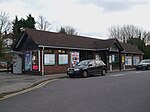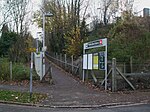Sanderstead

Sanderstead is a village and medieval-founded church parish at the southern end of Croydon in south London, England, within the London Borough of Croydon and the historic county of Surrey. It takes in Purley Downs and Sanderstead Plantation, an area of woodland that includes the second-highest point in London. Sanderstead sits above a dry valley at the edge of the built-up area of Greater London. Cementing its secular identity from the late 19th century until abolition in 1965 it had a civil parish council. The community had a smaller farming-centred economy until the mid 19th century. All Saints' Church's construction began in about 1230 followed by great alterations and affixing of monuments including a poem attributed to John Dryden, the first Poet Laureate nationally; it is protected under UK law as Grade I listed. Sanderstead station is at the foot of the dry valley and has frequent, fast trains to East Croydon, connected to a range of London terminals and interchanges. Sanderstead is claimed to an origin of the English Sanders surname, noting at least four separate geographical clusters formed by the 19th century, two of which were by 1881 far more populous.Sanderstead's Interwar growth coincided with the electrification of the Southern Railway leaving largely a suburban community of households having at least one commuter to central London or Croydon.
Excerpt from the Wikipedia article Sanderstead (License: CC BY-SA 3.0, Authors, Images).Sanderstead
Shaw Close, London Sanderstead (London Borough of Croydon)
Geographical coordinates (GPS) Address Nearby Places Show on map
Geographical coordinates (GPS)
| Latitude | Longitude |
|---|---|
| N 51.3358 ° | E -0.0818 ° |
Address
Shaw Close
Shaw Close
CR2 9JD London, Sanderstead (London Borough of Croydon)
England, United Kingdom
Open on Google Maps











